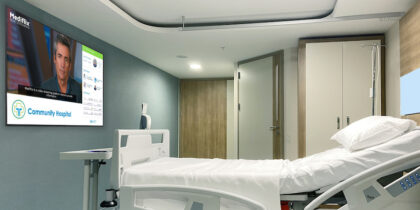In the past, loyal employees received a gold watch after they reached a milestone at their company. Today, many employers are handing out smartwatches to their entire workforces — not as gifts, but to promote health and wellness.
Wearables give people a better snapshot of their lifestyles, and with support from corporate wellness programs, individuals can make lifestyle adjustments that contribute to a healthy workforce and a healthy bottom line. Simply put: As teams gets fit, insurance premiums go down and productivity goes up.
Modern employers understand the value of wearable technology in healthcare. Eighty percent are “interested in” or bought wearable devices for their teams, according to a recent report by Springbuk, which presents the annual Healthiest Employer award.
However, employers aren’t leveraging the full potential of wearable technology in healthcare. Most companies use these devices simply to track participation. Only 25 percent use them in strategic planning for wellness programs, and 22 percent use them to assess the overall health of their staff.
How can employers get more bang for their buck? By providing tools for a healthy lifestyle and using those tools to drive engagement and measurable outcomes.
The Business Case for Healthcare Wearables at Work
Employee wellness is no longer a “personal problem.” Along with absenteeism and productivity losses caused by chronic illness, the rising cost of healthcare makes employee wellness a business priority.
Over the past 10 years, the average premium for family coverage increased by 69 percent, according to a 2014 study completed jointly between the Kaiser Family Foundation and the Health Research & Educational Trust. This drove employer contributions up from $7,289 per worker in 2004 to $12,011 in 2014. Unless Americans get healthier, the total price tag could reach $24,000 per family by 2020.
Hoping to avoid these cost increases, most companies now offer wellness services for employees. The problem is getting people to participate. To engage workers and get measurable outcomes from wellness programs, savvy employers are looking for new ways to help their teams make healthy lifestyle changes. According to Springbuk, “one of the most promising is the rise in wearable devices.”
Insurance companies agree. A 2015 Accenture report found that approximately two-thirds of insurers believe healthcare wearables will be adopted broadly by their industry within the next two years. Of the 31 percent whose companies already use wearables to engage customers, half are seeing a positive return on their investments.
As more insurance providers begin to adopt healthcare wearables, employers that use wearables to track health data won’t just save money from reduced claims. They’ll get discounted rates up front.
What Makes a Wearable Worth It?
Sophisticated wearables do more than track steps. For example, the Samsung Gear Fit also monitors sleep patterns, calories and heart rate. Samsung smartwatches come loaded with S Health, a platform that helps users set personal fitness goals and provides personalized coaching. It also enables users to collect and share health data.
This functionality landed Samsung on Springbuk’s list of top workplace wearables. To create the list, Springbuk surveyed employers across industries and ran an internal pilot test to determine which devices, best-engaged users, while providing valuable health data.
What should employers look for when purchasing wearables? Springbuk identified five key criteria:
- Usability: Unless the device interface and app are intuitive and easy to use, only avid exercisers are likely to use them, while those who could benefit most may remain disengaged.
- Application: Strategic planning helps to ensure wearables actually enhance wellness programs, rather than simply becoming expensive gifts with no real business value. Wellness goals will vary based on each team’s demographics and health challenges.
- Data: Once you’ve identified your program goals, determine which data will help you reach them. “Tracking usage and steps only scratch the surface of driving change,” said Springbuk’s study. “For example, imagine tying device data to specific chronic conditions to track improvement. Now, there’s real value in making your diabetic population more engaged in personal health.”
- Community: Springbuk’s internal testing showed significantly higher activity levels when workers could share and compare their individual results with each other. “We can’t understate the value of the social competition component,” the Springbuk report states. “Friends and coworkers with similar devices will find each other and engage in challenges. This interaction strengthens the experience and ensures a longer-term adoption.”
- Price point: The cost of wearables varies tremendously, which is why strategic planning becomes so important. “Don’t shy away from expensive options,” the study said. “Depending on the size of your order, some manufacturers offer a volume discount from the full retail price.”
Ready to give your wellness program a boost? Check out this white paper, “Transforming Wellness Programs.”







